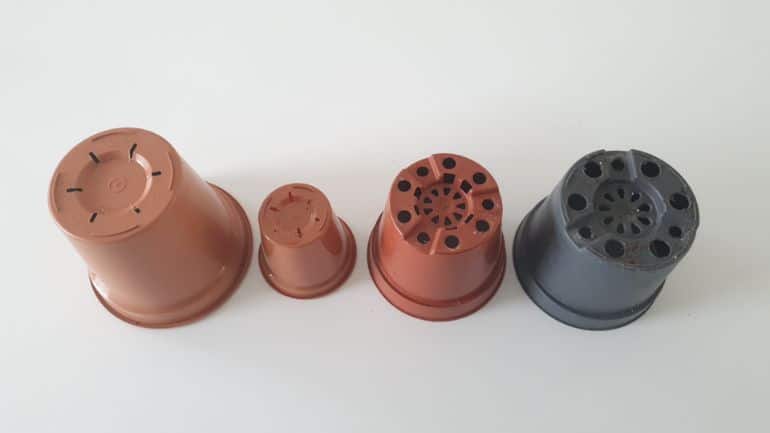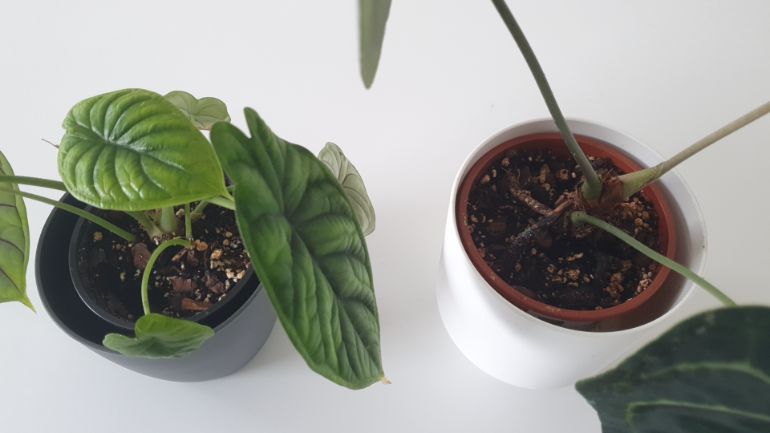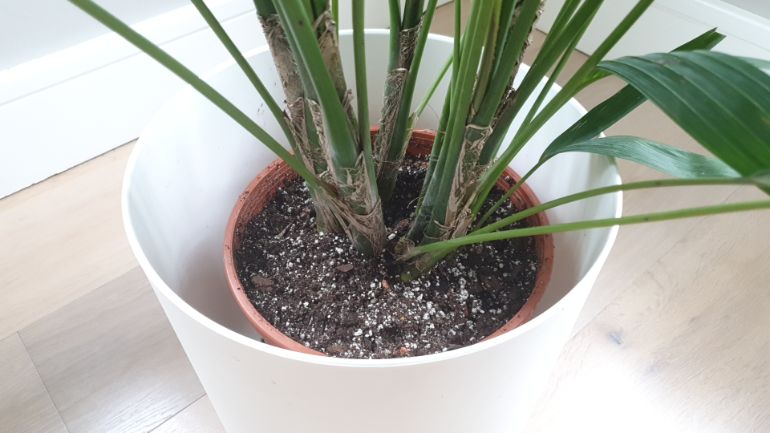If you’ve noticed that it takes your houseplant soil a long time to dry out, this is usually a sign of a problem. Most plants like their soil to progressively dry out after being watered, rather than sitting in constantly soggy soil. This article is going to cover all the causes of soil not drying out and show you how to fix each issue.
Soil not drying out is usually a sign that drainage or evaporation is insufficient, or water use by your plant is reduced. Increase light, ventilation, and temperature to increase evaporation and water use by your plants. Make sure the soil drains thoroughly and the container has drainage holes.
Why Is My Soil Taking So Long To Dry Out?
There are a lot of reasons why soil can take a long time to dry out, but they all relate back to issues with drainage, water loss through transpiration or evaporation, or reduced water use by your plant. The following are the main things that can increase the length of time your soil takes to dry out.
Low Light
Plants use much less water in low-light conditions, resulting in their soil staying wet for much longer after watering. If your plants are kept in low light conditions, much of the water that you add to the soil will stay there unused for a long time if the plant has no use for it.
By moving your plants to a brighter location, they will start to grow much quicker, and you will see a dramatic decrease in the length of time it takes for the soil to dry out. Low light is one of the most common reasons why people end up killing their houseplants because it becomes so easy to overwater them in this situation.
Low Temperatures
Low temperatures result in reduced evaporation of water from the soil, slowing the rate at which soil dries out. It also results in your plants having reduced transpiration and a reduced growth rate, with lower water requirements as a result.
I usually like to monitor the temperature in the rooms I grow my houseplants in to make sure they are not exposed to temperature extremes. I use a digital thermometer that records the minimum, maximum, and current temperature, so I good a good idea of whether temperature fluctuations are causing any issues. Drafty windows or drafts from heating or cooling appliances can cause large temperature swings.
In addition to reduced evaporation, low temperatures can also stress your plants, or directly damage them, which will dramatically reduce their ability to make use of water within the soil.
Poor Ventilation
Reduced ventilation around your plants decreases the rate of evaporation and transpiration, leading to soil that takes longer to dry out. Adding a fan, or simply opening a window can increase ventilation and lead to soil that dries out faster, reducing the risk of overwatering problems.
Poorly Draining Soil
If you notice that water pools on the soil surface after watering, or takes a long time to drain out of the drainage holes after watering, it is likely the soil is insufficiently well-draining. Many ready-made houseplant soil mixes are great at retaining water but tend to drain poorly, which can result in the soil not drying out for a long time after watering.
Adding inorganic amendments such as perlite or pumice to a houseplant potting mix can make a huge difference to drainage, and help the soil dry out much faster. These materials help water drain quicker, reduce the overall water-holding capacity of the soil, and improve soil aeration, largely preventing the issue of soil not drying out quickly enough.
Potting your houseplants in suitable soil is one of the most important aspects of growing healthy houseplants. I’ve written an article about choosing and making houseplant soil which covers everything you need to know.
Pots With Few Or No Drainage Holes
Pots without drainage holes retain all water added to the soil until it is either used from the plant or evaporates from the soil. This can result in the soil staying wet for a prolonged period of time. It is extremely difficult to grow healthy houseplants in pots without drainage holes. Sure, it can be done, but requires meticulous attention to detail and has a low margin of error.
It is much better to pick a pot with plenty of drainage holes right at the bottom of the pot. Avoid pots with drainage holes that are not right at the bottom of the pot, as these can result in water pooling in the bottom inch or so of the pot.
Some pots, like those pictured on the left below, simply have drainage holes that are too small, and won’t help that much with soil drainage. Try to pick pots with lots of drainage holes, particularly if using plastic pots.

Excessively Large Pots
This is a surprisingly common issue, and one that people often don’t realize is a problem. The greater volume of soil in large pots holds much more water than smaller pots. Unless you are growing equally large plants that can use such a large volume of water, the soil will take a long time to dry out.
Try to pick pots that match the size of your plants. It’s a good idea to leave your plants a little space to grow, but excess space is likely to do more harm than good.
When repotting plants, I normally recommend increasing the diameter of a plant pot by no more than 1-2 inches for exactly the same reason. Overpotting results in the soil not drying out quickly and leaves your plant at risk of root rot.
Choice Of Pot
Non-porous pot materials such as plastic and metal hold water within the soil much better than pots made of porous materials, such as terracotta. Switching to a porous material can greatly increase the rate at which the soil dries out.
Although I tend to use plastic pots for most of my plants, this does make it considerably more difficult to keep my plants healthy. I tend to use plastic pots as they are lighter and easier to place inside decorative pots. There are pros and cons of all pot materials and you can read more about that in this article.
Is It Bad For Plants When Soil Dries Slowly?
Soil that dries slowly is bad for plants as it means that the roots are sitting in soggy conditions for a prolonged period of time. This can result in symptoms of overwatering, root rot, and can even result in your plant dying. In general terms, if the soil in a pot takes more than two weeks to dry out, it is probably drying too slowly and may cause problems for your plant.
Overwatering is one of the most common problems when growing houseplants, resulting in soggy soil conditions that cause root rot. When root rot sets in, the plant cannot gain the essential water and nutrients from the soil that it needs to thrive, and this often results in the death of the plant.
It’s not the abundance of water in the soil that causes problems for the plant, but the lack of oxygen. Roots need well aerated soil to survive and thrive, and soggy soil results in the air spaces in the soil getting filled with water, preventing gas exchange between the roots and the air. Over time, this weakens the roots, leaves then susceptible to disease, and ultimately results in them dying.
How To Check Whether Soil Is Dry?
It’s fair enough to talk about soil not drying out, but how do you actually check the soil. It seems like such a simple thing to do, yet it’s really easy to misjudge how wet or dry soil is.
Soil can often feel dry on the surface, but be soggy just an inch or two beneath the surface. Other times, if the soil isn’t soaked evenly when watering, this can lead to a wet soil surface, but a lack of moisture deeper down or around the roots of the plant, where it is needed most.
Here are some tips to make sure you check the soil for dryness properly;
- Rather than just feeling the soil surface, dig a finger a few inches into the soil to feel for moisture.
- Check the weight of the pot. You will start to know when your plant needs water by checking the weight of the pot. The difference in weight between wet soil and dry soil is quite considerable.
- Feel the soil through the bottom drainage holes for wetness. This is a great method for plants that like their soil to dry fully before being watered.
- Poke a dry skewer into the soil. Remove it after 10 seconds and check for wetness. This will quickly tell you if the soil is still wet deeper down.
- Some people like to use moisture meters. I find that just using my finger and feeling the weight of the pot is more accurate. However, moisture meters can be helpful, particularly for larger pots.
- Use a combination of methods, rather than just one, to check the wetness of the soil.
- You can read more tips on how to tell when to water your houseplants here.

How Can I Make My Soil Dry Faster?
The main ways to make soil dry faster are to increase light, heat, and ventilation for your plant, ensure the soil and pot are draining well, and choose an appropriately sized pot for your plant. Consider moving to a pot made of a porous material such as terracotta, and make sure to drain the pot well after watering.
There are likely to be a number of factors causing the soil to dry slowly, but a few small changes to several issues can make a big differnece, leading to a much healthier plant.
How To Dry Wet Soil Fast
If your plant is showing some of the early signs of overwatering, there are a few easy ways to remove moisture from the soil to help it dry out quickly and prevent further damage to your plant.
- Slide your plant out of its pot and wrap kitchen towels or newspaper around the damp soil. Gently press these against the soil and water will be absorbed onto the paper. This will quickly remove a portion of the water from the soil and greatly increase the aeration of the soil.
- Another option is to set your plant on dry soil after removing it from its pot. The dry soil will also absorb some of the water by capillary action and you will notice the soil becoming noticeably drier after a few hours.
- Drying soil with a hairdryer – After removing your plant from its pot, use a hairdryer on the cool setting near the soil. You’ll need to be careful not to blow the soil off the roots, but this can help dry the soil a lot without harming the plant.
- Another option is to gently remove some of the soil from the periphery, taking care not to disrupt the rootball where possible. You can then repot in the same container and backfill with some dry soil. This is a quick fix that I have used a number of times. You’ll need to fix any other underlying issues, but it helps to quickly dry the soil and quickly improve your plant’s condition.
Last Word
Overwatering and root rot caused by soil not drying out is one of the most common problems people experience when growing houseplants. Avoiding this by giving your plants appropriate lighting, soil, and pots will make a world of difference and make growing plants so much more enjoyable.
If you’d like to read more about keeping your houseplants healthy and avoiding common issues, check out some of my other articles below. You can also take a look at my book, “Houseplants Made Easy“, which covers everything you need to know to go from being a houseplant novice, to confidently growing beautiful houseplants year after year.
- Understanding Light Requirements For Houseplants
- What Pots Are Best For Houseplants
- How To Choose And Make Perfect Houseplant Soil
- 25 Hard To Kill Houseplants You Will Love
- Overwatering Vs Underwatering (And How To Fix Both Easily)

